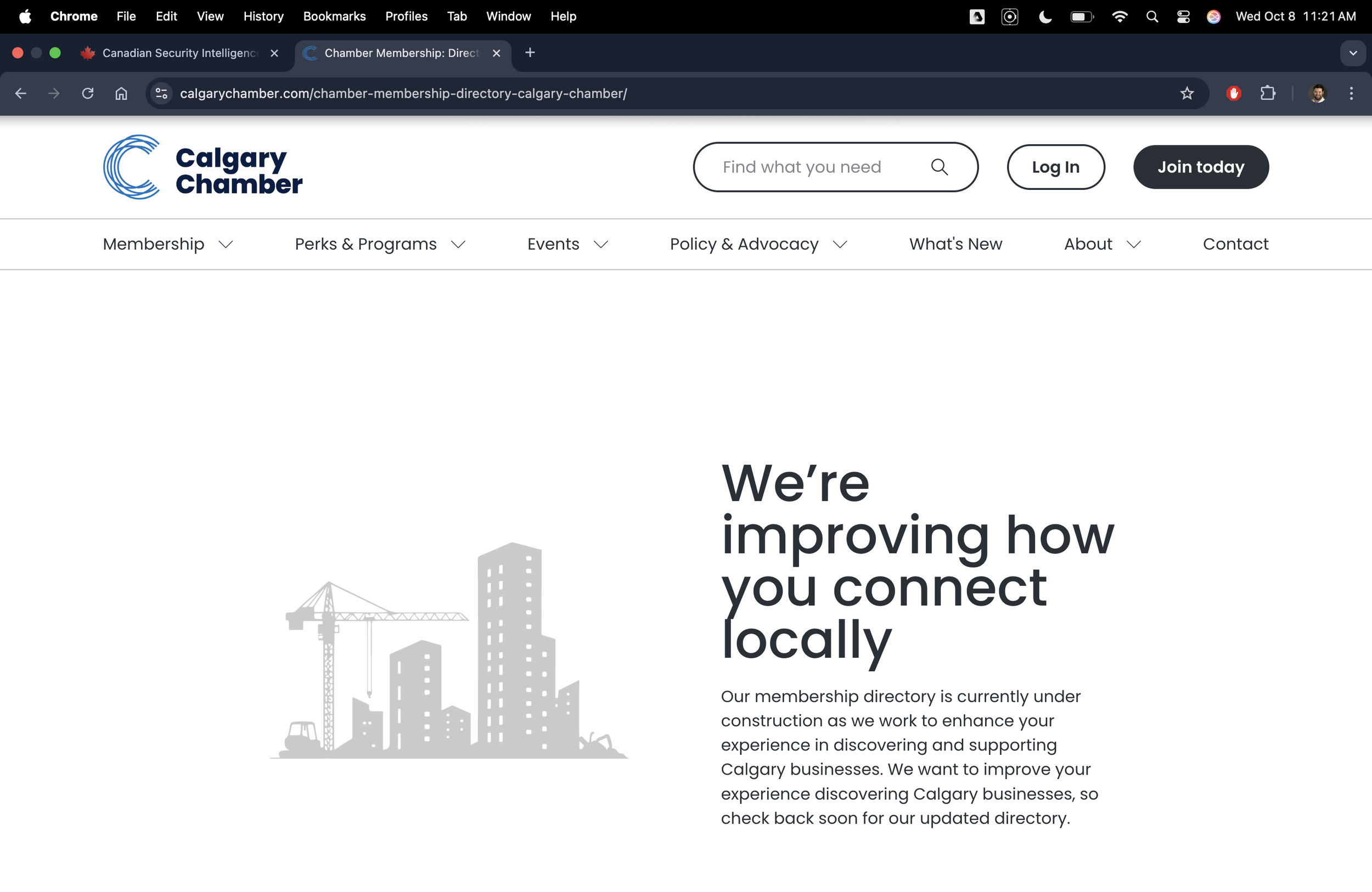Critical City Infrastructure Access and National Security
Smart cities represent the next generation of critical national infrastructure, integrating transportation, energy, communications, healthcare, and governance into a single digital network. They are the central nervous system of modern civilization — and thus, prime targets for espionage, sabotage, and cyber warfare by hostile actors.
As Calgary evolves into a connected, data-driven metropolis, its digital infrastructure becomes as vital as its roads and power lines. Every sensor, camera, and network node is both an asset and a potential vulnerability.
RISK: Inadequate Data Governance
According to Canadian Security Intelligence Service (CSIS) assessments, inadequate data governance remains one of the most critical threats facing municipalities today.
Key vulnerabilities include:
Cyber Operations: Hostile states and organized criminals exploiting digital entry points to disrupt municipal systems.
Insider Threats: Breaches from individuals within the system, including contractors, consultants, or administrators with privileged access.
When digital infrastructure is poorly protected, an attack on data becomes an attack on democracy.
SOLUTION: Citizen Engagement and Structural Resilience
CSIS emphasizes that prevention starts with citizen engagement. By involving Calgarians early in the design of smart systems, we build public understanding, accountability, and resilience.
Awareness transforms the population from passive consumers of technology into active defenders of civic integrity.
However, engagement must be supported by structural strength — clear governance, unified command, and professional training.
THE CALGARY PROTECTION FORCE INITIATIVE
This is why Dr. Jaeger Gustafson has proposed the unification of police, emergency, and intelligence services under a single budget with increased oversight:
The Calgary Protection Forces (CPF).stand out
At the heart of this modernization are the 300 Resilience Officers — specialists trained to bridge investigation, prevention, and recovery across cyber, fire, and emergency domains.
They will serve as the bridge of intelligence between emergency response / management, bureau of investigative support, and long-term threat assessment.
To support this mission, Gustafson’s plan includes the creation of a world-class training facility. This will create 1,500 new jobs, offering a three-year Bachelor’s Degree in Public Resilience and Emergency Operations, followed by a one-year field practicum in one of the Calgary Protection Forces.
This advanced education model ensures that every officer is cross-trained in:
Water / Environmental / Conservation Management and Research
Fire and Medical Rescue Operations
Cybersecurity / AI / Quantum Algorithm Fundamentals
Crisis Psychology and Public Communication
Interdepartmental Coordination and Lawful Intelligence Gathering
FAILURE OF INSTITUTIONAL GOVERNANCE
The same vulnerabilities visible in data governance are mirrored in certain civic institutions.
The Calgary Chamber of Commerce, for example, functions as a private membership organization with limited transparency — including the participation of a large amount of numbered corporations that obscure ownership and accountability issues during the 2025 municipal election.
During municipal election cycles, such opacity has led to questionable exclusion practices and a perceived lack of neutrality, undermining public trust.
Work conducted under the direction of our Chief Resilience Officer:
The City of Calgary has been working to repair its reputation with only 52% trust score with Calgarians According to the 2025 Spring survey presented to council on May 22, 2025.
To prevent institutional corruption or manipulation of civic platforms:
Membership structures must be transparent.
Agreements for statutory appointments must include enforceable dispute-resolution clauses.
Public-facing organizations with statutory responsibilities must maintain neutrality during elections.
THE PATH FORWARD
The future of Calgary — and of Canada’s security — depends on the unification of intelligence, education, and engagement.
The Calgary Protection Force represents not just an emergency service, but a new model for civic sovereignty, where data, safety, and democracy are protected.
Legislative Briefing: Modernization of Airport Governance under the Regional Airports Authorities Act
Prepared for Legislative Counsel — Calgary Protection Force: Critical Infrastructure Oversight Initiative
Background
The Calgary Airport Authority (YYC) operates as a non-profit regional airports authority established pursuant to Alberta’s Regional Airports Authorities Act (RSA 2000, c R-9).
Under the Authority’s founding documents and bylaws, the Board of Directors is appointed by four distinct entities:
Long-Range Planning Committee of the Calgary Chamber of Commerce
City of Calgary
Rocky View County
Government of Canada (Federal)
(Sources: YYC.com – Leadership & Governance; City of Calgary Board Registry; Wikipedia entry on Calgary Airport Authority; BM Public Calgary Board Information Portal.)
The current governance structure allocates up to 11 of 17 total board seats to appointees of the Long-Range Planning Committee of the Calgary Chamber of Commerce, a private membership organization.
This allocation was originally intended to reflect business engagement in airport growth and economic development during the 1990s. However, in 2025, Calgary International Airport constitutes a critical component of Canada’s national transportation and digital infrastructure, intersecting with defense, cybersecurity, and emergency management networks.
Problem Definition
The present appointment system presents governance and security vulnerabilities inconsistent with modern national security and public accountability standards:
Lack of Statutory Oversight:
The Regional Airports Authorities Act does not prescribe public-sector majority control or set mandatory qualifications for directors of regional airport authorities.Opaque Appointment Mechanism:
The Calgary Chamber of Commerce—a private body not subject to Alberta’s Freedom of Information and Protection of Privacy Act (FOIP)—appoints the majority of YYC’s board members through its Long-Range Planning Committee, with no requirement for disclosure of membership, procedures, or potential conflicts of interest.Critical Infrastructure Designation Gap:
YYC functions as a national critical node for air transport, communications, logistics, and border control, yet its board composition lacks any legislated requirement for security-clearance vetting, resilience training, or public safety representation.Fragmented Security Coordination:
Airport security oversight is divided among municipal fire and rescue, federal agencies (Transport Canada, CATSA, CBSA), and corporate operators without an integrated resilience governance framework.
Legislative Objective
To amend the Regional Airports Authorities Act and associated Regulations (Alta Reg 149/1990) to ensure:
Public accountability and transparency in the appointment of airport directors.
Inclusion of national security and resilience expertise in governance.
Integration of municipal, provincial, and federal oversight through a Critical Infrastructure Security Committee.
Proposed Legislative and Regulatory Amendments
1. Amend Section 13 (Composition of the Board of Directors)
Add subsections specifying:
Public-sector majority rule:
No fewer than 50% + 1 of directors shall be appointed by public bodies (municipal, provincial, or federal).Limit on private appointers:
No more than one-third of board members may be appointed by private or quasi-private organizations.Security qualification requirement:
At least one-third of all directors must hold valid Government of Canada security clearance (Level II or higher) and certified training in resilience, cyber governance, or emergency management.
2. Amend Section 14 (Appointment Procedures)
Insert provisions requiring:
All appointer organizations to publish governance policies, conflict-of-interest declarations, and membership transparency statements.
Each appointment to be confirmed by a Public Safety Review Panel, composed of representatives from:
The Calgary Protection Force (municipal security authority)
The Government of Alberta’s Public Safety and Emergency Services
Transport Canada
This confirmation process mirrors the oversight model used for Police Commissions and ensures national security compatibility.
3. Add a New Section: “Critical Infrastructure Security Committee”
Create a statutory committee under the authority of the Minister of Transportation or Public Safety to audit and advise on infrastructure resilience and emergency response planning for regional airports.
Composition:
Representatives from municipal Fire, Rescue, and Cyber Divisions
Liaison officers from Transport Canada and Public Safety Canada
One municipal and one provincial security liaison
Observers from the Canadian Forces Joint Task Force West (for emergency logistics coordination)
Mandate:
Conduct annual Resilience & Security Audits of airports and related infrastructure (e.g., CTrain tunnels, energy corridors).
Report findings to the Minister of Public Safety and the relevant municipalities.
Recommend improvements to emergency coordination and cyber-defense practices.
4. Transitional Governance Protocol
Establish a two-year transition during which the Calgary Chamber of Commerce retains partial appointment power subject to joint confirmation by the Public Safety Review Panel.
After the transition period, the Chamber’s appointees would represent no more than 30% of the total board composition.
Chamber-appointed directors must file an annual disclosure of interests and participate in mandatory resilience training certified by the Calgary Protection Force.
Legal Effect
These amendments would:
Bring Alberta’s airport governance framework in line with federal critical infrastructure protection standards.
Restore public-sector accountability for the management of a major national transportation asset.
Strengthen Calgary’s resilience posture by integrating emergency management, cyber-defense, and municipal safety planning.
Conclusion
This reform does not diminish the Calgary Chamber of Commerce’s historical contribution to YYC’s success; rather, it recognizes that critical infrastructure governance in the 21st century requires security-clearance standards, public transparency, and multi-level coordination.
Amending the Regional Airports Authorities Act accordingly will ensure that YYC remains both economically dynamic and nationally secure under the Calgary Protection Force framework.
“When you call for help — someone should always come. Fast.”
— Dr. Jaeger Gustafson






